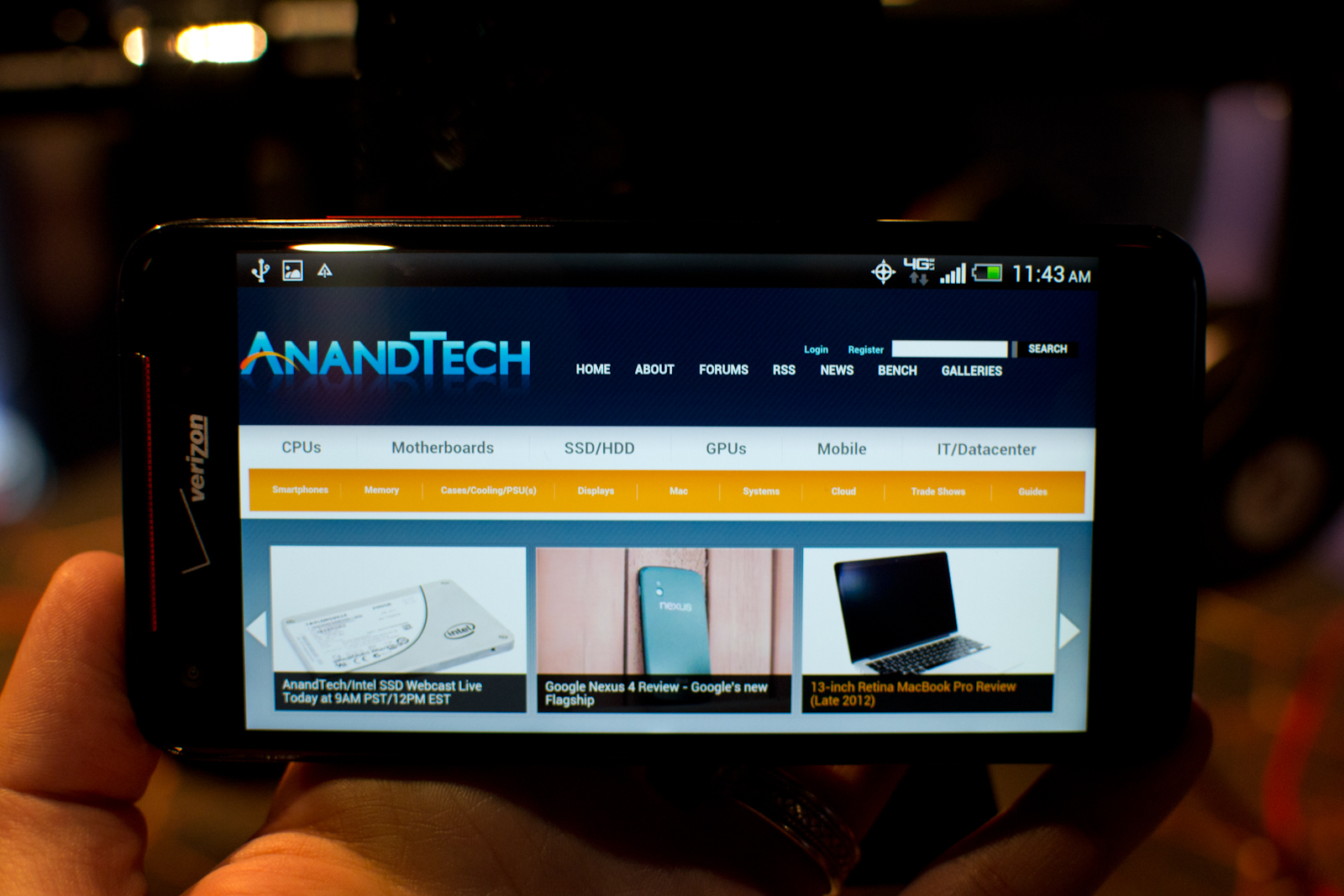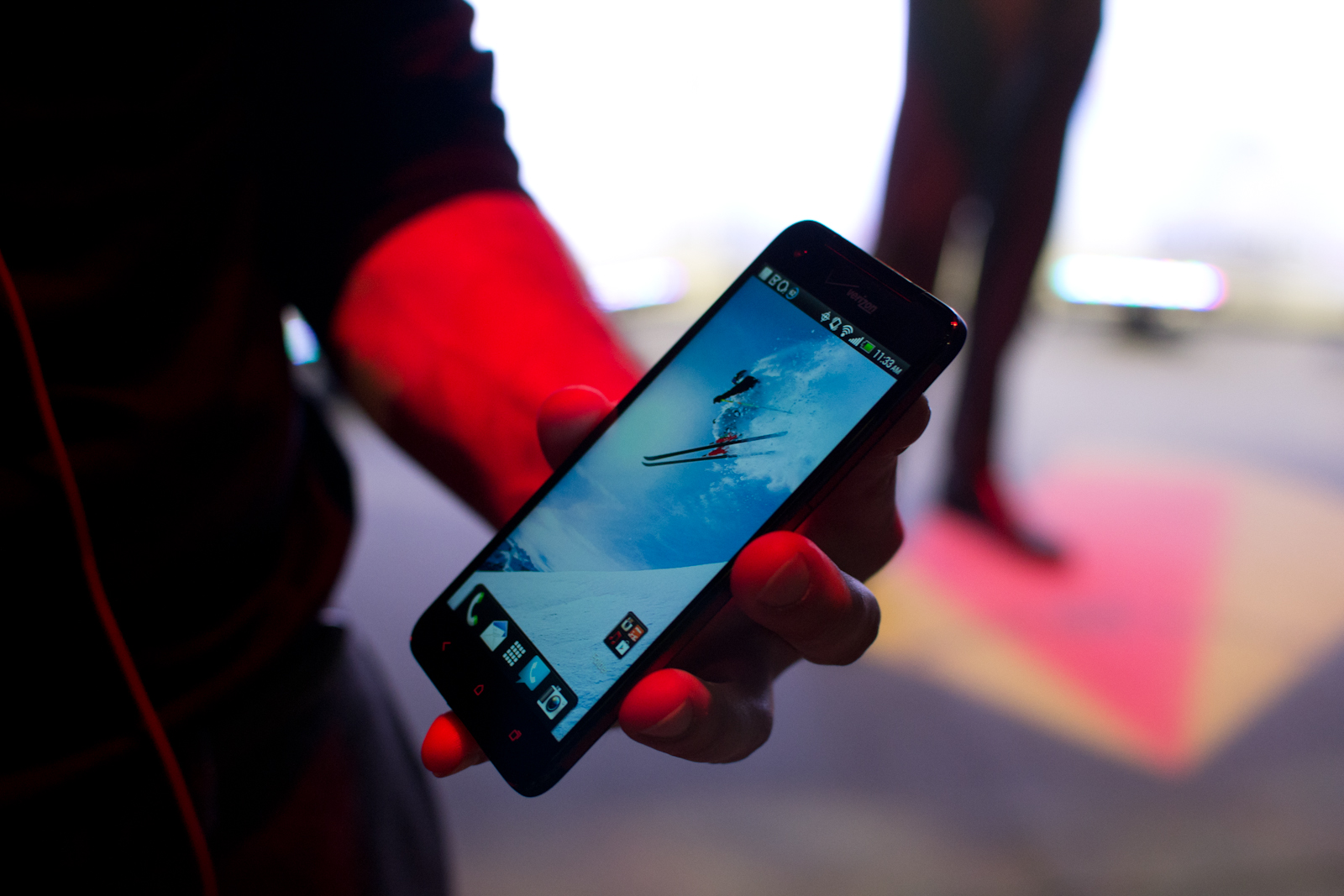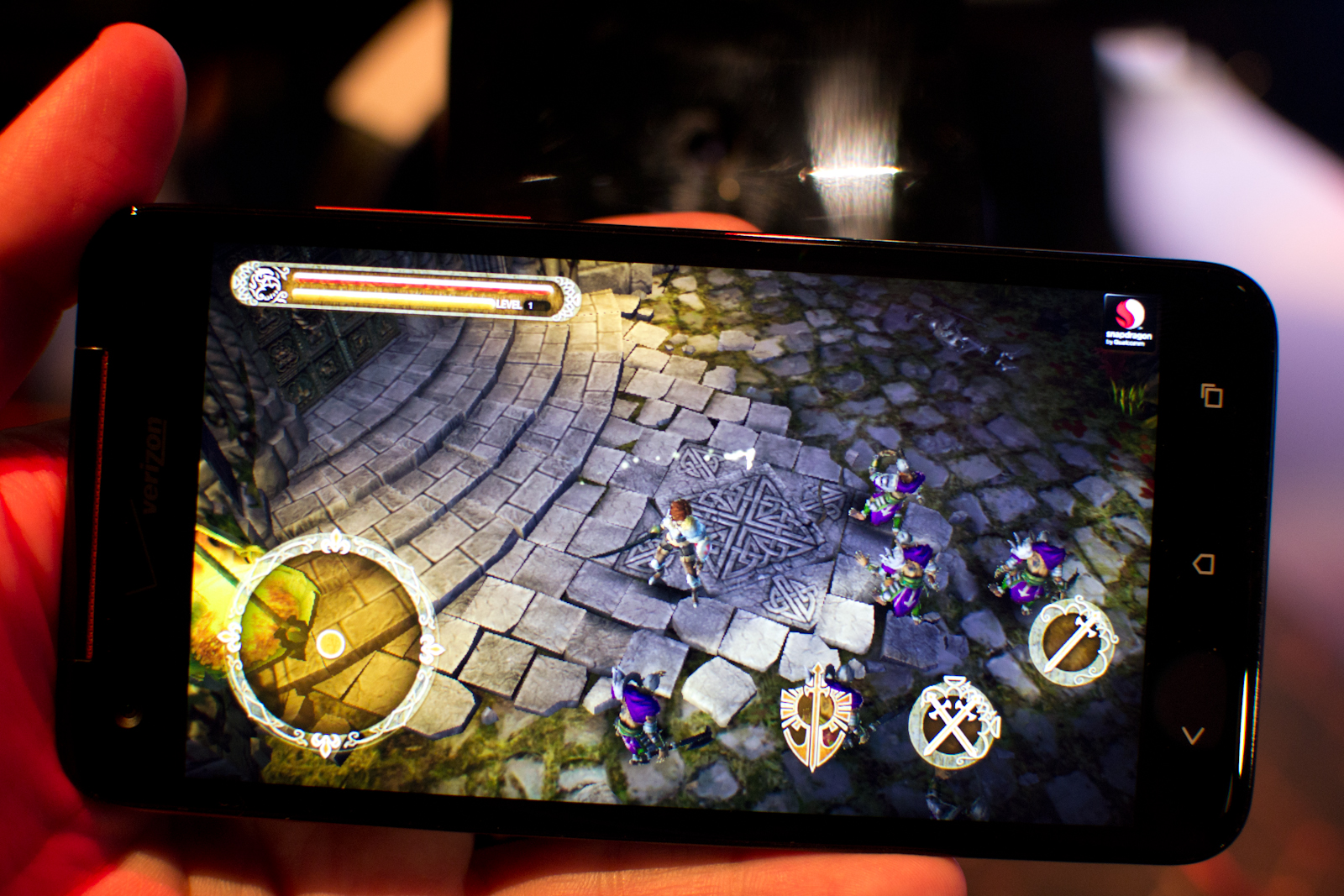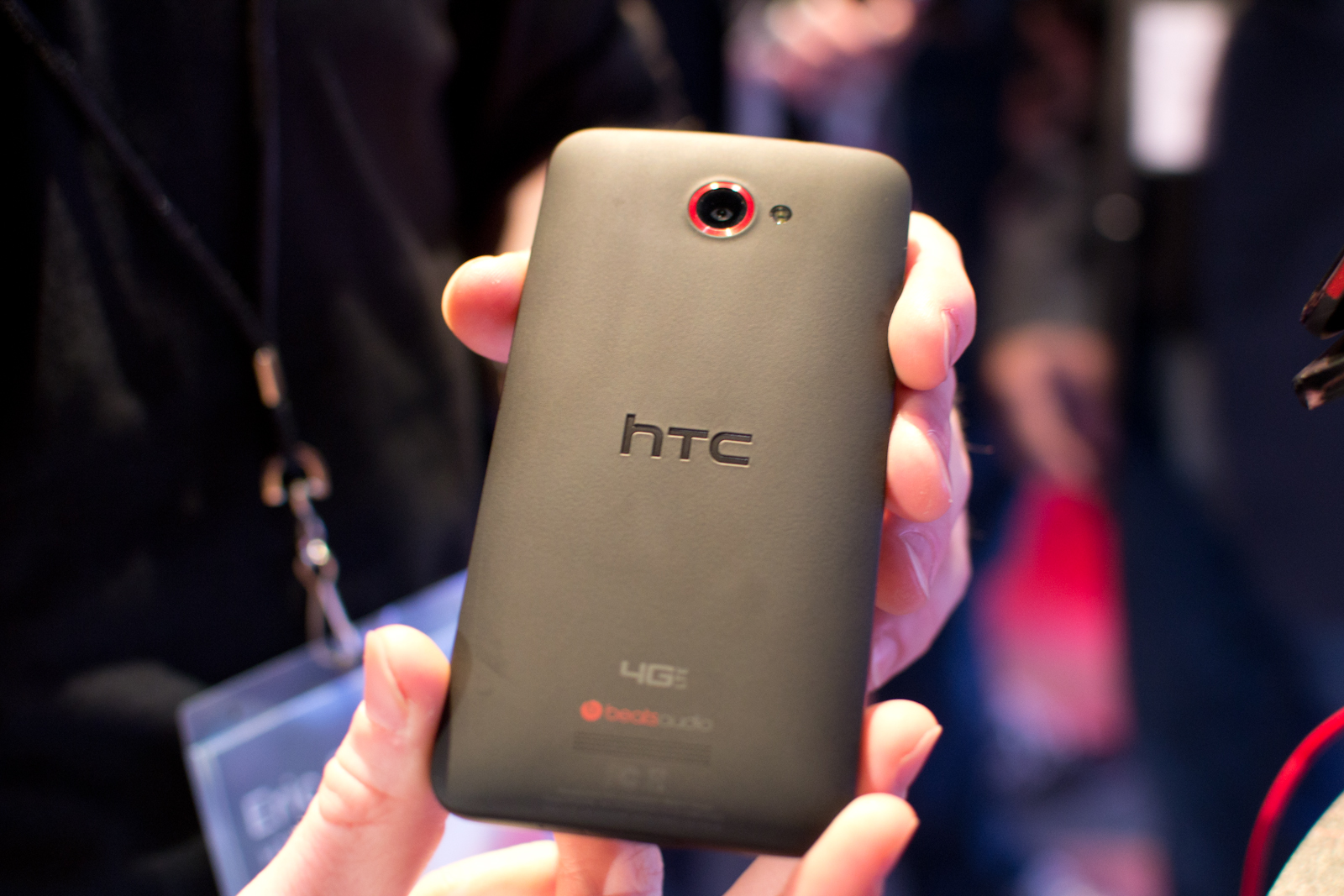HTC Droid DNA Hands-On
by Jason Inofuentes on November 13, 2012 12:22 PM EST- Posted in
- Smartphones
- Snapdragon
- HTC
- Verizon
- Mobile
- APQ8064
- droid dna
Today’s HTC Droid DNA announcement brings a few big advancements over the HTC One X that never made it to Verizon's line-up. We'll start our hands-on discussion with the most obvious change: the screen.
The Display

The rapid advance of screen technology means that we're just a year removed from the arrival of 720p displays, and just two years removed from WVGA being the defacto resolution. Today we see the efforts of Sharp’s display team come to fruition with a seemingly uncompromised 5" 1080p display. The pixel density is an unchallenged 440 ppi, and it seems to retain the brightness and fidelity of its predecessors, most recently seen in the HTC One X.

Hands-on events aren’t the place for detailed analysis, the time is too short, and the venues to cramped to pull out a colorimeter. What I will say is that the display is easy on the eyes and offers such a glut of pixels that no amount of squinting allowed me to discern. Viewing angles seemed good, with no distortion noted, and colors were bright without being oversaturated. So, at first glance, a somewhat expected excellent for the display. Here’s the thing: do we want a 1080p 5” display? At this pixel density, we would be approaching an angular subtense of two thirds of a degree. That's well below the human ability to discern at twelve inches. So is the likely battery hit worth the improved pixel density? We'll have to wait and see.
The Design

The great display is surrounded by narrow bezels all around, and the result is a body that is just 6.2 mm longer than the One X, despite the larger screen, and less than a millimeter wider. Gorilla Glass 2 is used and actually extends across the entire face of the device and forms part of the edge of the handset, a surefire sign of confidence in the strength of the glass. The effect is to make the front glass and back seem fused into one solid piece. Accent grills adorn the sides of the device, in the bright red we’ve come to expect from HTC phones on VZW. The back is a softly curving single expanse of matte black, with the HTC logo etched and inlayed in silver. An LTE logo, Beats Audio logo and the single speaker grill grace the bottom of the back, and the 8MP rear-shooter sits at the top. One particularly unique feature on the back is a concealed status LED to the left of the camera lens. When the phone is face down and a notification is received, the LED will blink to alert the user. The LED is also used to alert self-shooters when the shutter will release.

At nearly a centimeter at its thickest point, this is not the thinnest phone; but the way the back tapers down to the edge gives it an excellent in the hand feel, and makes it feel thinner than its specifications would indicate. Despite deviations from the One series design language, the solidity that defines that lineage can be seen here.
| Physical Comparison | ||||
| HTC Droid DNA | HTC One X (AT&T) | Samsung Galaxy S 3 (USA) | LG Nexus 4 | |
| Height | 141 mm (5.55") | 134.8 mm (5.31" ) | 136.6 mm (5.38") | 133.9 mm (5.27") |
| Width | 70.5 mm (2.78") | 69.9 mm (2.75") | 70.6 mm (2.78") | 68.7 mm (2.7") |
| Depth | 9.73 mm (0.38") | 8.9 mm (0.35") | 8.6 mm (0.34") | 9.1 mm (0.36") |
| Weight | 142 g (5.01 oz) | 129 g (4.6 oz) | 133 g (4.7 oz) | 139 g |
| CPU | 1.5 GHz APQ8064 (Quad Core Krait) | 1.5 GHz MSM8960 (Dual Core Krait) | 1.5 GHz MSM8960 (Dual Core Krait) | 1.5 GHz APQ8064 (Quad Core Krait) |
| GPU | Adreno 320 | Adreno 225 | Adreno 225 | Adreno 320 |
| RAM | 2 GB LPDDR2 | 1 GB LPDDR2 | 2 GB LPDDR2 | 2 GB LPDDR2 |
| NAND | 16 GB NAND | 16 GB NAND | 16/32 GB NAND with up to 64 GB microSDXC | 8/16 GB NAND |
| Camera | 8 MP with AF/LED Flash, 2.1MP front facing | 8 MP with AF/LED Flash, 1.3 MP front facing | 8 MP with LED Flash + 1.9 MP front facing | 8 MP with AF/LED Flash, 1.3 MP front facing |
| Screen | 5" 1920 x 1080 LCD-TFT | 4.7" 1280x720 LCD-TFT | 4.8" 1280x720 HD SAMOLED | 4.7" 1280x768 HD IPS+ LCD |
| Battery | Internal 7.47 Whr | Internal 6.66 Whr | Removable 7.98 Whr | Internal 8.0 Whr |
The Camera
Cameras, like displays before them, were long ignored as just value adds, and not features that must be optimized and perfected. It’s really exciting to see manufacturer’s compete for the best phone camera and not just through software trickery. HTC’s approach is, perhaps, the most traditional, and that is to provide an optical package that mimics the higher-end discrete glass you’d find on a proper SLR. The same f/2.0 28mm optics package is used here, as in the One X, and most likely the same sensor is in play. The ImageChip ISP remains a feature, and the software (now called Sense 4+) has a few additions to improve usability. It’ll be interesting to see how Sense 4+ and Android 4.2’s new camera software will play together, but for now the camera seems intuitive and the results look to match that of the One X.
The front-camera from the HTC WIndows Phone 8X finds a home here, bringing its f/2.0 optics, ultra-wide angles and 2.1MP sensor, which shoots 1080p video.
The SoC
Obviously, we’ve spent a little time with this particular SoC, recently. UI performance was smooth, and hard to trip up, even with the graphical flourishes HTC favors. The home screen carousel is no more, but cycling through home screens remains a wrap around affair and a second tap on the home button still brings an overview of all your home screens. All those flourishes render fluidly, and hopping in an out of apps and the app drawer, I didn't notice any particular hiccups. Performance should be excellent in our typical tests, based on SoC alone, but software is always a key component to the experience, and it'll be interesting to see how this S4 Pro equipped handset differs from the Nexus 4 and LG Optimus G.
The Audio
HTC has been focusing on handset audio for sometime, including their investment in and use of Beats Audio's DSP algorithms. Beats Audio remains, and there’s even a VZW tie-in with the Beats Pill, a portable Bluetooth speaker. Added to the mix is a dedicated 2.55v headphone amp, which should be able to drive even the most high-end cans. Sound quality should be improved in all headphones, and they were certainly able to power my modest earbuds well. No specifics were provided, but a dedicated amp for the rear speaker should give audio a boost there, as well. This sort of focus on audio quality is always nice to see, and we’ll be excited to put the DNA through its paces to see how it stacks up.

















54 Comments
View All Comments
JasonInofuentes - Tuesday, November 13, 2012 - link
We'll see how the battery capacity issue plays out, but I'm curious about the general feeling people have that SD cards are a necessity. I have a 16GB GS3 as my daily driver, and a 32GB micro SD card inside it, and I honestly can't think what's on that SD card. Android has been moving away from user provided SD storage, both in its Nexus line AND in the vanilla software.I run CM10 on my GS3, and there's almost no place for my SD card in the software. The 16GB of NAND is plenty for pictures, apps and data; and the only time I've run into space issues is when I forgot to delete old back-ups and ROM files. So, what do you do with your SD storage? Is it full of movies and media? Full of apps?
Impulses - Wednesday, November 14, 2012 - link
I like having about 16GB of music around, so unless phones start moving to 32GB minimum I'll keep longing for the slot... There's a ton of usage cases out there, it's always silly to rationalize that because you don't need it others won't.It's also the principle of the thing, people know 32GB microSD cards are like $20, so when a manufacturer wants to sell a device with an extra 16GB for $50-100 more it just rubs them the wrong way.
I know Google devs have gone on these technical rants about how it makes sense to eliminate removable storage but it seems to work juuust fine on my EVO. /shrug
JasonInofuentes - Wednesday, November 14, 2012 - link
Briefly, I wasn't rationalizing anything, that's why I was asking you what your specific use case merited requiring the storage.Now, the mark-up has more to do with marketing and margins, they charge far more for the additional storage because pricing things are complex and because they need to ensure that the products move. Price the bigger device to closely, and sales of the lesser one suffer. Price the bigger device too high and it won't move. But there's one other factor, if you price wrong or simply build to much of the larger SKU, you want to make sure that the loyal buyers that seek out that larger SKU are covering the losses from having so many of that SKU linger on shelves.
I believe in Android's devs reasons for wanting to eliminate SD cards, and it actually doesn't apply to your use case much. It applies to the sort of access you see when running apps from the SD card. But yours is an edge case, and the other use cases are also probably on the periphery. So, unless you're a big phone switcher, you should probably expect to buy the larger SKU for your next phone.
Thanks for the comments. Cheers.
Jason
Impulses - Wednesday, November 14, 2012 - link
You've got data that proves most usage cases for additional storage are fringe cases or are we taking the industry's word for it like we do with bandwith caps? :p I if I assumed your intentions but that's usually where most people are headed with that question.Apps became kind of a moot point IMO when phones started shipping with enough memory for a ton of apps (around last year), so while the reasons to avoid microSD may be valid they may not apply to most of the cases where people actually want that extra storage.
I think some of the security reasons to avoid removable storage are probably more valid than the technical logistic issues.
At the end of the day it doesn't really matter why they try to milk the consumer with the larger SKU, to the consumer all that matters it's that they're doing it and that it leaves a bad taste in your mouth. :/
There's also a lot of usage cases not to be underestimated, like it being much easier to recover data after an accident from a card than from a phone (pics for instance), though that goes back to the matter of security (and cloud storage and bandwith caps!).
I'm sure the issue sort of solves itself in the long run as it all becomes cheaper, in the short term the enthusiast is screwed tho (and last I checked this site should/would usually stick up for the enthusiast...).
I adapted to sealed batteries without as much of an issue, ended up realizing a USB battery pack was often more convenient than powering down, taking the case off, swapping, and powering back up... The improved battery life of this year's phones also helped. That still didn't mean I liked the option being taken away, and that's the crux of it.
More than anything Android's about user choice and having options, so this flies in the face of that to an extent.
Impulses - Wednesday, November 14, 2012 - link
That should've read "I apologize if I assumed your intentions" dunno where the word went, happens sometimes when editing in Swype.My other big issue with unified storage btw is MTP, it's ideal for unified storage and I like that it can be mounted without disabling stuff on the phone etc... But it's annoying when it comes to actually putting stuff on the phone.
There's network/cloud apps and services that sidestep the issue but HTC's (and Samsung's?) approach of having phone storage handled thru MTP and removable storage thru regular mass storage seemed like the perfect compromise to me.
Impulses - Wednesday, November 14, 2012 - link
Also, USB OTG goes a long way towards mitigating some of these issues and it's another compromise many would be happy with... Unfortunately HTC's kernels rarely have support for it (Samsung's usually do). This rarely gets mentioned in reviews (even AT's extensive reviews), not sure why, it's such a useful and versatile feature to have.I don't think every review/article needs to beat this dying horse but it'd be nice to see a simple "no microSD, which is lamentable" if only as a sign that it's something enthusiasts still care about, rather than simply letting manufacturers get away with it, so to speak. You guys beat them over the head for plenty of other things.
It'd be nice if Brian could do a simple check for USB OTG support during reviews, again, if only to show it's something enthusiasts care about.
Peanutsrevenge - Wednesday, November 14, 2012 - link
As there's no +1 and I fully agree with your comment I'll simply:PLUS 1!
Peanutsrevenge - Wednesday, November 14, 2012 - link
For me:I like to have all my music with me that's not compressed to a silly level (especially if the phone has a headphone amp (really interested in this for the review)).
I like to be able to have whatever TV show I'm going through at the time on my HTPC so I can watch while out and about with nothing to do.
I also carry around a lot of software and drivers with me (PC Tech) and SD cards are easier than USB sticks.
It's also useful if a friend has some data to throw your way for whatever reason.
The price premium most manufacturers charge for the extra few GB of crappy eMMC is also stupid. Granted it's still quicker than even the quickest SD cards, but for most stuff it's not really much of an issue, certainly not enough to justify the cost IMO.
For other people I can imagine:
Going on holiday and using phone for video and picture taking.
Transfer a few 1080p films across (what's the point in a 1080p screen if you watch crap quality films)....
deputc26 - Wednesday, November 14, 2012 - link
yep... thispiroroadkill - Thursday, November 15, 2012 - link
100% agreed.No microSD in a phone this size and a battery smaller than that in the RAZR MAXX? Give me a break, HTC.
Give us a huge battery and microSD!